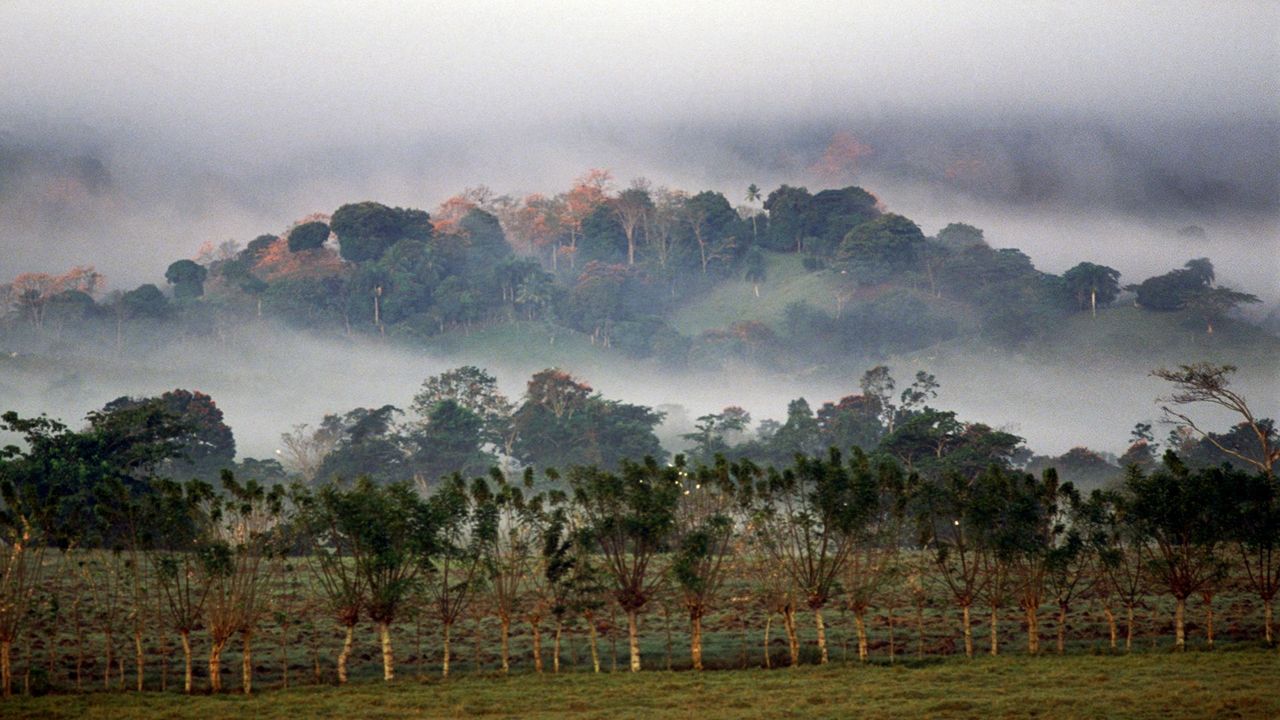How planting trees is bringing clean water to a tropical nation
The Dominican Republic’s forests are being cut down for grazing land – and it’s also having a serious effect on the water supply. Is planting new trees a natural solution to the crisis?
Dominga Reynoso turned her rusted, squeaky tap above the kitchen sink. Nothing, not even a drop, came out. Even the pipes, which usually gurgled in anticipation, stayed silent. Reynoso and her neighbours, who live in Santo Domingo, the capital of the Dominican Republic, would go without running water for 22 days – an increasingly common occurrence across the mountainous Caribbean island of Hispaniola, which the country shares with Haiti.
Historically, the country has relied on bountiful natural supplies of water, which are freely accessible to both public and private entities. Over the past century, however, that supply has been under threat. Increased demands from the tourist, mining, and agricultural industries have meant less is left for local people.
“Economic and population growth are putting great pressure on the Dominican Republic’s traditionally bountiful water resources,” says Chloe Oliver Viola, a senior water supply and sanitation specialist at the World Bank. “Reforms and greater investments are urgently needed to ensure sustainable use and safe water supply for businesses and households.”
Decades of deforestation to make way for cattle grazing, natural disasters like hurricanes destroying already-fragile sewer systems and infrastructure, and mismanagement of water resources have resulted in the country experiencing a water crisis it has never seen before, says Francisco Núñez, the Central Caribbean director of The Nature Conservancy, a nonprofit organisation specialising in water and land conservation. “We’re going through a severe drought,” he says. “Animals have been dying, crops failing. To build a dam to conserve water supplies is not enough – we need nature to provide water, we need to go back to the ecosystem and rebuild from the beginning.”

In 2011, Núñez helped launch a multi-country project called the Latin American Water Funds Partnership, bringing millions of dollars of funding from conglomerates such as the world’s largest bottler of fizzy drinks, to invest in water projects in the Latin America and Caribbean regions. The partnership established 24 water funds throughout the region, forming a set of guidelines in order to set standards and best practices for each fund.
Núñez, who was born and raised in the Dominican Republic, spearheaded two water funds in his home country – one restoring three river basins in the Santo Domingo region, and one high in the mountains, in the watershed of the Yaque del Norte, the longest river in the country. The aim of the water funds is simple, says Patricia Abreu, head of the Santo Domingo Water Fund: “to focus on nature-based solutions contributing to achieve water security for the future”.
To achieve this, the projects have been increasing tree canopies, ensuring the water is managed efficiently, delivering clean water to local communities, and bringing sustainable and long-term economic empowerment to rural areas – through environmentally beneficial industries.
The Yaque del Norte river basin is home to significant agricultural production, as well as being the country’s second-largest metropolitan area, which has led to increasing tension between water users. “As an island state, we’re very vulnerable to climate change,” Abreu adds. “And the effects are altering the way the water cycle works.” Of all the water on Earth, only 0.5% is fresh water available for industrial, agricultural and domestic use. This water is found in groundwater aquifers, freshwater lakes, and rivers – areas vital to the world’s water supply, and which are under threat from deforestation, habitat degradation, and expansion of cities. Although Latin America has the most water sources in the world, 36 million people in the region lack access to clean drinking water.
Núñez and Abreu estimate the drought has been ongoing since 2015, although there is a lack of scientific research within the country when it comes to environmental issues. “It’s a huge challenge,” says Abreu. “As a country we need to build up better data about our water sources – both surface water and underground aquifers. There’s not a whole lot of information about what state they’re in. And we need that information for better decision making, and to work out how we approach the threats of a degraded system.”
Much of The Nature Conservancy’s work has been around data gathering, education, and involving all water users – from public utilities to private corporations to rural farming communities. “Our aim is to get everyone involved, and everyone educated, on the importance of conserving and properly managing water,” Núñez says. “This model is about everybody coming together to work on the same goal.”
The organisation’s work starts at the very beginning of the watershed ecosystem, at 10,000ft (3,030km) in the Cordillera Central mountain range, also known as Madre de las Aguas (Mother of the Waters). Around 80% of the country’s population depends on the water from this area, which is also the source of the Yaque del Norte. The land, which used to be covered in lush, green vegetation, is now severely degraded, with roads cutting across the parched landscape, stripped of native trees and heavily grazed by cattle. “There’s an understanding now that if we want to fix the water crisis, we need to rebuild the watersheds,” says Núñez.
The team began approaching small scale farmers living in these rural, mountainous areas with a proposition: The Nature Conservancy would help plant either coffee or cacao crops – both plants help prevent soil erosion, which leads to better water retention in the watershed. They are also highly valuable economically; the country is a major exporter of organic fair trade cocoa. Planting a valuable crop means that money is being brought into these rural areas, and farmers are more likely to stick with that crop.
Farmers see how well their neighbours are doing with our programme and they want to sign up – Francisco Núñez
Alongside planting coffee and cacao, the organisation seeds other plants to shelter these crops and help them grow – a practice known as agroforestry. The technique has also been found to improve water resiliency, as trees pull water from the ground and release it into the atmosphere as vapour through a process called transpiration, which leads to local rainfall.
Farmers are also trained in how to monitor the land, aiding in collecting vital data that is fed back to The Nature Conservancy, helping inform future projects and observe progress. “The technicians came and gave us courses and lectures on how to plant cacao,” says Digno Pacheco, a farmer participating in the Santo Domingo project. “Here in this small town there isn’t much work. And we see the benefits of undertaking this cacao project because in the future we can harvest cacao, more people can work, and our economic situation can improve.”
At first it was tough to convince farmers, Núñez says, as there was little trust in outside programmes and not a lot of understanding about how watersheds worked. It took months to persuade the first handful, but now “we have a waiting list”, he explains. “Farmers see how well their neighbours are doing with our programme and they want to sign up!” The farmers are compensated for planting trees on their farmland, and The Nature Conservancy provides the seeds and fertilisers. To date, no farmers have pulled out of the project.
The project aims to impact the watersheds that produce water for drinking, agriculture,e and electricity, which would benefit more than 60% of the country population, by improving water supplies in urban and rural communities and increasing sanitation and waste treatment. The project has also trained 370 Dominicans in water conservation practices and restored 8,000 acres (3,237 hectares) of water-producing ecosystems.
“There’s no Plan B when it comes to water,” says Abreu, who has seen firsthand how managing the watershed in the mountains can positively impact people in the city – like Dominga Reynoso. “Water security is so important for sustainable livelihoods, for human health and for economic development in countries like ours,” he says. Up to 40% of households spend 12% of their income on bottled water, while six out of 10 urban households report an intermittent water supply. More than two-thirds use bottles or tanks to store water for daily consumption.

Two-thirds of Dominican homes don’t have sewage connections which treat wastewater
Water quality is just as important as the quantity available, highlights Walkiria Estévez, director of the Yaque del Norte project. Residents in poverty-stricken areas repeatedly report water discoloration and odours from government-run taps, which leaves them at risk of contracting serious illnesses, including cholera. Two-thirds of Dominican homes don’t have sewage connections which treat wastewater, and that leads to groundwater contamination, a World Bank review found in 2021. In the capital, which has the highest rate of treated water, just 28% is treated, The Nature Conservancy found.
“It’s a problem we really needed to tackle,” says Estévez, “and so we started building artificial wetlands to naturally treat wastewater in rural and suburban for communities.”
The Nature Conservancy has built 23 wetlands so far in the Yaque del Norte, Nizao, Ozama, and Haina water basins, with the biggest treating sewage from 1,500 families. These natural filtration systems, built using layers of sand and gravel and native plants such as vetiver, reduce pollutants by up to 98% without using any kind of chemicals or electricity, according to The Nature Conservancy. The water is absorbed by the manually dug basins and drained out through a pipe once it has filtered through the layers of sediment. The water then either goes back to the rivers or is used for irrigating small scale crop growing community projects.
Following the construction of the wetlands, 300,000 cubic metres (10.6 million cubic ft) of sewage water is now treated every year, diverting contaminated water from the rivers, which many locals still use to collect water for laundry, cooking, bathing, and cleaning. The most recent wetland was built in a school, and the team trained teachers to use the artificial ecosystem to educate students about environment and ecology.
You might also like:
- ‘We are not climate refugees – we are pioneers’
- Why US ranchers are becoming beaver believers
- A 2,000-year-old way to water crops
The World Bank recently loaned the Dominican Republic’s government $43.5m (£35.4m) to expand and improve clean water supply and sanitation services in two municipalities on the north coast of the country. The project aims to provide wastewater treatment services to 90,000 people and access to clean water for 105,000 people – 12,700 of whom will be connected to a water supply for the first time.
The government has begun to move forward with policy reforms to address the fragmented framework that currently covers water resources, irrigation and sanitation services, and which is at the root cause of poor water management. (A 2021 World Bank report described the water and sanitation sector as locked in a “vicious cycle”.) In addition, the government has proposed establishing a National Water Authority to lay out guidelines of water resource management. In 2023, the government launched a programme to improve the efficiency of state-owned water providers.
Whilst the government pushes through its top-down legislative reforms, Abreu continues to fight for water on the ground. “Most important to me is the way we integrate everyone in the country, to come together to cooperate for a greater objective,” she says. “Gathering data is important, but we’re translating the data to comprehensive projects that can actually respond to the challenge of water security.”
And the results suggest the approach works. The land that has undergone careful restoration is starkly different from the untouched areas: healthy trees with full foliage dot the landscape; streams are flowing and clear, with vegetation lining the banks; lush green grass covers the hills. It’s a vast improvement to the dry, arid conditions that Abreu and her team were faced with a decade ago.
Over the next 10 years, they hope to double their impact, expanding to 15 more communities, helping another 6,000 people gain access to clean water, and restoring another 12,000 acres (4,856 hectares).
The Dominican Republic’s Environment Ministry did not respond to requests for a comment.


